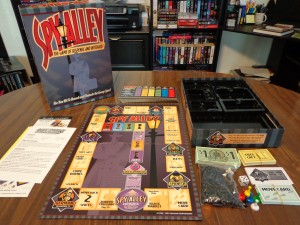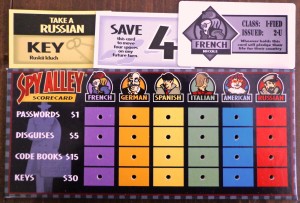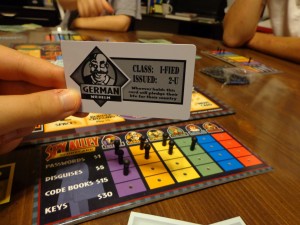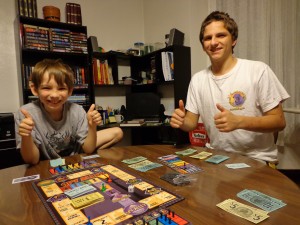Being a spy is a lot of work, if television has taught us anything. You have beautiful women constantly throwing themselves at your feet and all the neat gadgets you could ever want, except for maybe the “cone of silence”…that thing never worked right.
Spy Alley is a game that challenges players to collect things without revealing what country they represent. Players will need to buy all of the items of their country in order to close in on victory, but can also buy items from other countries to throw other players off in their suspicions. Let’s take a quick look at the components and gameplay before heading into the review.
Components
Spy Identification Cards – Each player will receive one, which lists what country they represent. There are a total of six countries. Players should do everything they can to keep this information a secret.
Scorecard & Pegs – Each player will be using a scorecard, along with pegs, to track what items they’ve purchased for what country. This also allows other players to see what an opponent has purchased thus far.
Cards – Free gift cards and move cards are collected when players land on particular spaces. They provide players with bonuses, either immediate or for use later on.
Money – Players will be collecting money so that they can buy the items that they need to win.
Game Board & Game Markers – Players will be using game markers to move around the board, via a die roll.
Setup & Gameplay
Each player receives a game marker, a scorecard, a spy identification card, and money equal to the number of players times ten. The player who goes first is determined by the highest die roll.
On a player’s turn, they will roll the die and move their marker, following the instructions as indicated by the space they land on. Players can opt to use move cards instead, if they have them (one per turn). As players purchase items, they’ll insert a peg into their scorecard under the appropriate item and country. The ultimate goal that players will be trying to shoot for is to collect the password, disguise, code book, and key of their country and then land on their country’s embassy space. If a player can manage to do that, they win the game.
A player can also win the game if they are the last spy standing. Instead of rolling the die to move, they can guess the identity of another spy. If they are correct, the spy that they are trying to expose is eliminated from the game. If they are incorrect, they are eliminated from the game instead. The spy still standing receives all of the items that their opponent has collected thus far and has the option to switch their spy identification card with the person who was just eliminated.
The above is simply an overview of the game, but should still give you an idea of what the game is like.
The Review
Spy Alley reminds me a bit of Clue and Monopoly…the former because you’re trying to use deductive logic to find hidden identities and the latter because you’re moving around the board buying and collecting things. However, the bluffing mechanic adds a nice twist to the game and rightly sets itself apart from both.
Speaking of which, the bluffing mechanic adds a bit of strategic flair to the game. Some players might opt to take a slow approach in gathering their country’s items while others might take a more direct approach and only buy an unnecessary item here or there. Players can also choose which countries to buy items for (in most cases), so some may buy items for all six countries while others might buy items for only two or three countries. It all comes down to how quick you can obtain your country’s items without giving yourself away, and that will change with each person you play against. You might be able to get away with more when playing against a child, for example, but you better have your poker face ready for someone who’s played five-card stud professionally and is watching your facial expressions like a hawk.
From a parent’s point of view, Spy Alley is definitely kid friendly. In fact, it’s simple enough to where it would appeal to people of all ages. Being at the mercy of bad die rolls can be frustrating at times, though the move cards and confiscate materials space (among other things) helps players to offset that. All in all, it is a fun, casual game that is definitely worth looking into.
Now if you’ll excuse me, *takes off shoe*, I have a call coming in…
Editor’s Note: Watch your “Get Smart”, kids.
Final Verdict: 6/10
—




